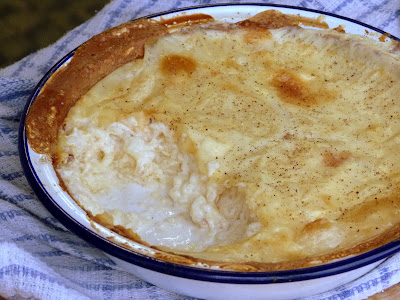How much debate can a handful of starch and a splash of dairy generate? Judging by the comments on Felicity Cloake's recent article about porridge on the Guardian website (250+ and still counting), quite a few.
As I've mentioned in previous posts the simplest dishes often seem the most highly disputed. Often if I'm writing about, say, an pasta dish, dim sum or tapas I will take some time to learn about its history, regional variations and any 'controversial' additions or omissions to keep things (reasonably) authentic. (Ketchup on your hot dog or Parmesan on a prawn risotto may get you a few funny looks in certain parts of the world.) But a traditional baked English rice pudding, despite it's many permutations, it's far easier to write about; quite simply I know what I like.
Leaving behind the horrors of school dinner slurry, rice pudding has become quite the trendy desert again. While it's great to see it making a comeback, many of the versions I have eaten recently have been too 'fancy' for my unusually Puritan pudding tastes. Even some of the tradition recipes seem rather lavish; The rice pud Simon Hopkinson and Lindsey Bareham write about in the fabulously retro Prawn Cocktail Years is made with cream and whole milk, while Eliza Acton's traditional recipe, followed by Delia Smith no less, also sees the addition of egg yolks and butter. All very delicious, but the richness of the dairy, plus the custardy texture provided by the eggs, is not the rice pudding of my childhood memories.
For me rice pudding would be a Sunday treat, made in a casserole dish that was a wedding present to my parents, and placed in a low oven to gently cook while the roast meat was resting. Just pudding rice, caster sugar, semi skimmed milk and a grating of nutmeg. Comfortingly bland, sweet and milky, a mixture of tender rice, blistered skin and a splash of cold milk to serve. As no one else in my family was too keen on it I usually got to scoff most of it myself, and somehow it managed to taste even better cold on a Monday.
Now I'm an adult I still love a bowl of simple rice pud on a Sunday, but the real change to my pudding eating habits is is something I never really enjoyed as a child: a big blob of jam dolloped in the middle. Strawberry if you've got it. And, thankfully there's no spelling homework after dinner now either!
Rice Pudding
100g pudding rice
50g caster sugar I use brown)
800ml milk (whole or semi-skimmed)
Fresh grated nutmeg
Bayleaf (optional)
Butter
To serve
Cold milk
Strawberry jam
Pre heat the oven to 150c and butter a heatproof baking dish.
Place rice sugar and milk into the dish, stir then add the bay leaf.
Grate fresh nutmeg over the suface of the pudding and place in the oven to bake for 1 1/2- 2 hours, stirring halfway through. The top should be golden brown, and the rice should 'wobble' slightly in the middle when ready
Serve with a little extra cold milk and jam.





























